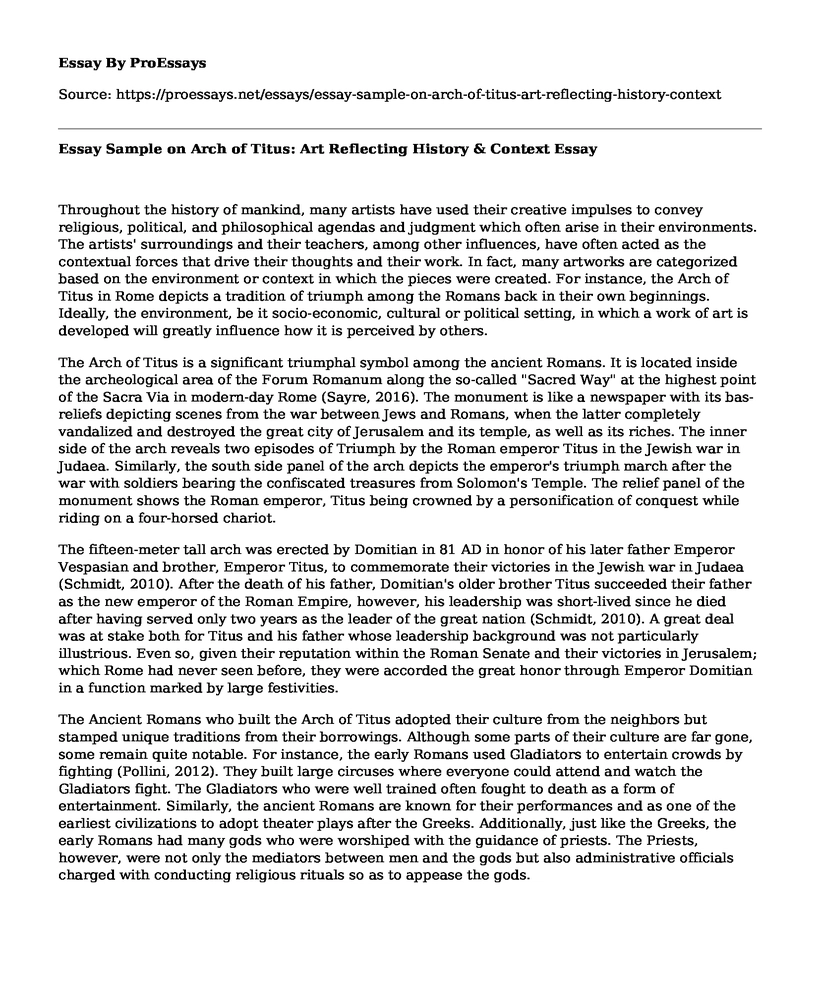Throughout the history of mankind, many artists have used their creative impulses to convey religious, political, and philosophical agendas and judgment which often arise in their environments. The artists' surroundings and their teachers, among other influences, have often acted as the contextual forces that drive their thoughts and their work. In fact, many artworks are categorized based on the environment or context in which the pieces were created. For instance, the Arch of Titus in Rome depicts a tradition of triumph among the Romans back in their own beginnings. Ideally, the environment, be it socio-economic, cultural or political setting, in which a work of art is developed will greatly influence how it is perceived by others.
The Arch of Titus is a significant triumphal symbol among the ancient Romans. It is located inside the archeological area of the Forum Romanum along the so-called "Sacred Way" at the highest point of the Sacra Via in modern-day Rome (Sayre, 2016). The monument is like a newspaper with its bas-reliefs depicting scenes from the war between Jews and Romans, when the latter completely vandalized and destroyed the great city of Jerusalem and its temple, as well as its riches. The inner side of the arch reveals two episodes of Triumph by the Roman emperor Titus in the Jewish war in Judaea. Similarly, the south side panel of the arch depicts the emperor's triumph march after the war with soldiers bearing the confiscated treasures from Solomon's Temple. The relief panel of the monument shows the Roman emperor, Titus being crowned by a personification of conquest while riding on a four-horsed chariot.
The fifteen-meter tall arch was erected by Domitian in 81 AD in honor of his later father Emperor Vespasian and brother, Emperor Titus, to commemorate their victories in the Jewish war in Judaea (Schmidt, 2010). After the death of his father, Domitian's older brother Titus succeeded their father as the new emperor of the Roman Empire, however, his leadership was short-lived since he died after having served only two years as the leader of the great nation (Schmidt, 2010). A great deal was at stake both for Titus and his father whose leadership background was not particularly illustrious. Even so, given their reputation within the Roman Senate and their victories in Jerusalem; which Rome had never seen before, they were accorded the great honor through Emperor Domitian in a function marked by large festivities.
The Ancient Romans who built the Arch of Titus adopted their culture from the neighbors but stamped unique traditions from their borrowings. Although some parts of their culture are far gone, some remain quite notable. For instance, the early Romans used Gladiators to entertain crowds by fighting (Pollini, 2012). They built large circuses where everyone could attend and watch the Gladiators fight. The Gladiators who were well trained often fought to death as a form of entertainment. Similarly, the ancient Romans are known for their performances and as one of the earliest civilizations to adopt theater plays after the Greeks. Additionally, just like the Greeks, the early Romans had many gods who were worshiped with the guidance of priests. The Priests, however, were not only the mediators between men and the gods but also administrative officials charged with conducting religious rituals so as to appease the gods.
References
Pollini, J. (2012). From republic to empire: Rhetoric, religion, and power in the visual culture of ancient Rome (Vol. 48). University of Oklahoma Press.
Sayre, M. (2016). Reveal a world of art (8th ed.). New York, NY: Pearson.
Schmidt, E. A. (2010). The Flavian triumph and the Arch of Titus: The Jewish God in Flavian Rome. Retrieved from https://escholarship.org/uc/item/9xw0k5kh
Cite this page
Essay Sample on Arch of Titus: Art Reflecting History & Context. (2023, Feb 27). Retrieved from https://proessays.net/essays/essay-sample-on-arch-of-titus-art-reflecting-history-context
If you are the original author of this essay and no longer wish to have it published on the ProEssays website, please click below to request its removal:
- Shoji Hamada: Potter in Japan Essay
- Essay Sample on Lasting Effects of Slavery in Gyasi's Book
- Annotated Bibliography: The Ending of Slavery
- The Abolition of Slavery: Its Impact on America's Rise - Interview Example
- The Rise of the Roman Empire: Political, Economic, Social and Geographical Factors - Essay Sample
- Exploring Ancient Greek Myths: Origins, Creatures & Heroes - Essay Sample
- Paper Example on Surf Wax







